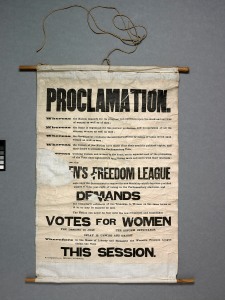On 23 May 2011, UNESCO announced the inscription of twenty archive documents and collections to its UK Memory of the World Register. I’m delighted to say that this included an inscription for Documentary Heritage of the Women’s Suffrage Movement in Britain, a collection of eight items held by The Women’s Library and the Parliamentary Archives.
The Women’s Library has magnificent women’s suffrage collections, of course. UNESCO has recognised a range of their documents from the 1866 petition which enabled John Stuart Mill to be the first person in Parliament to call for women’s suffrage, to a congratulatory letter from Prime Minister Stanley Baldwin to Millicent Fawcett on achieving equal franchise in 1928. This banner design is by Mary Lowdnes from her album of designs for the Artists Suffrage League, dated c.1908.

- National Union of Women’s Suffrage Societies banner, The Women’s Library, Artists Suffrage League Archive, 2ASL/11/1
The Parliamentary Archives documents recognised by UNESCO include two contrasting original Acts of Parliament. The Prisoners (Temporary Discharge for Ill Health) Act 1913, known as the ‘Cat and Mouse’ Act, allowed hunger-striking suffragettes who were released from prison while weak or ill to be re-imprisoned once recovered, while the Representation of the People (Equal Franchise) Act 1928 gave women the vote on the same terms as men. Also inscribed from the Parliamentary Archives by UNESCO is a Women’s Freedom League banner, which is my personal favourite because of the story behind it.

It was unfurled by suffragettes in the Ladies’ Gallery in the House of Commons on 28 October 1908. They pushed it through the grille covering the gallery window and lowered it into the chamber. Meanwhile two of the women chained themselves to the grille and had to be cut off by authorities in a committee room. One of these women was Australian suffragette Muriel Matters, demonstrating the international nature of the women’s suffrage movement. The banner was left behind in the House of Commons after the event, and today it stands as both a literal and metaphorical representation of the protests made by women behind the grille.